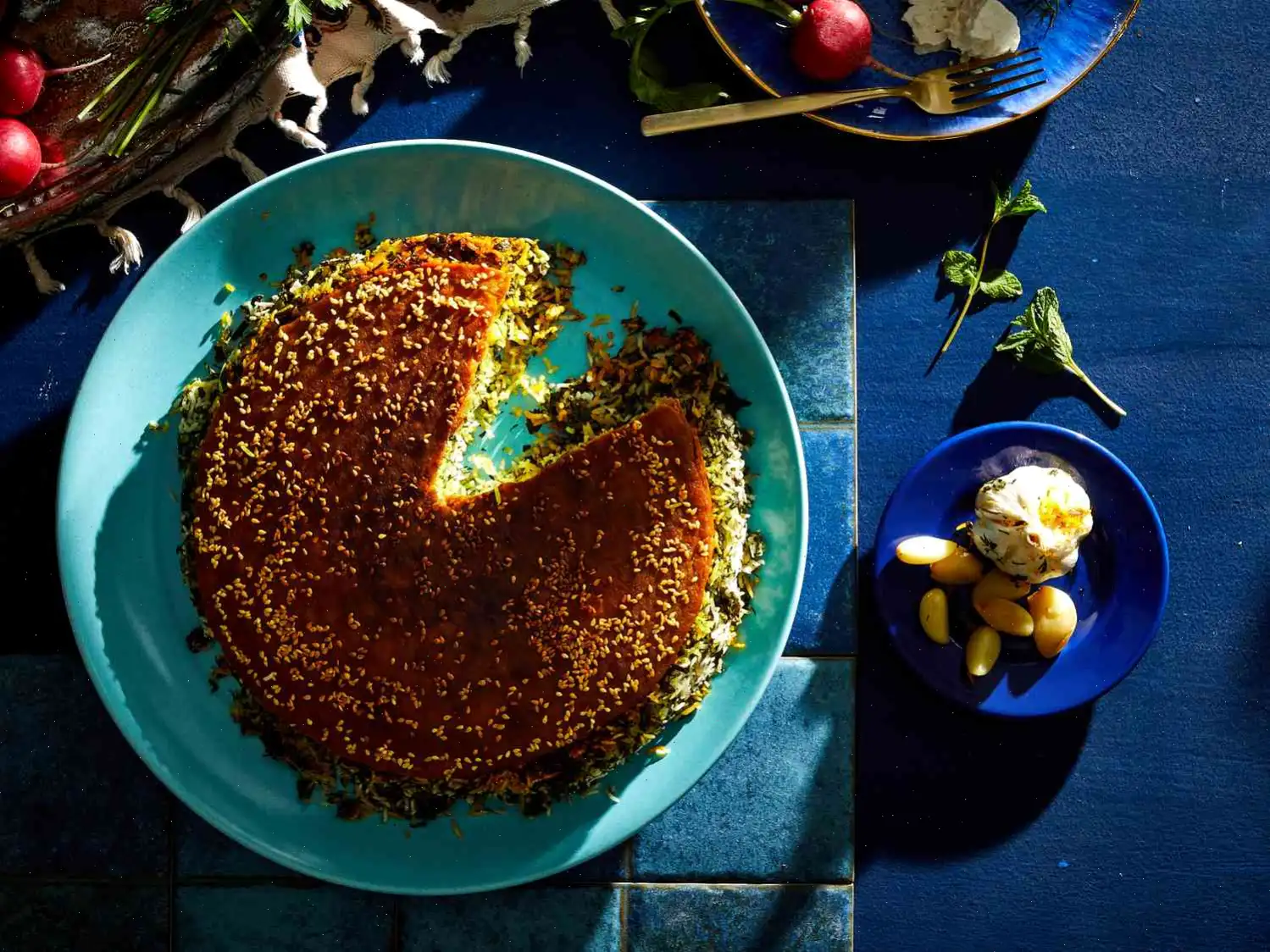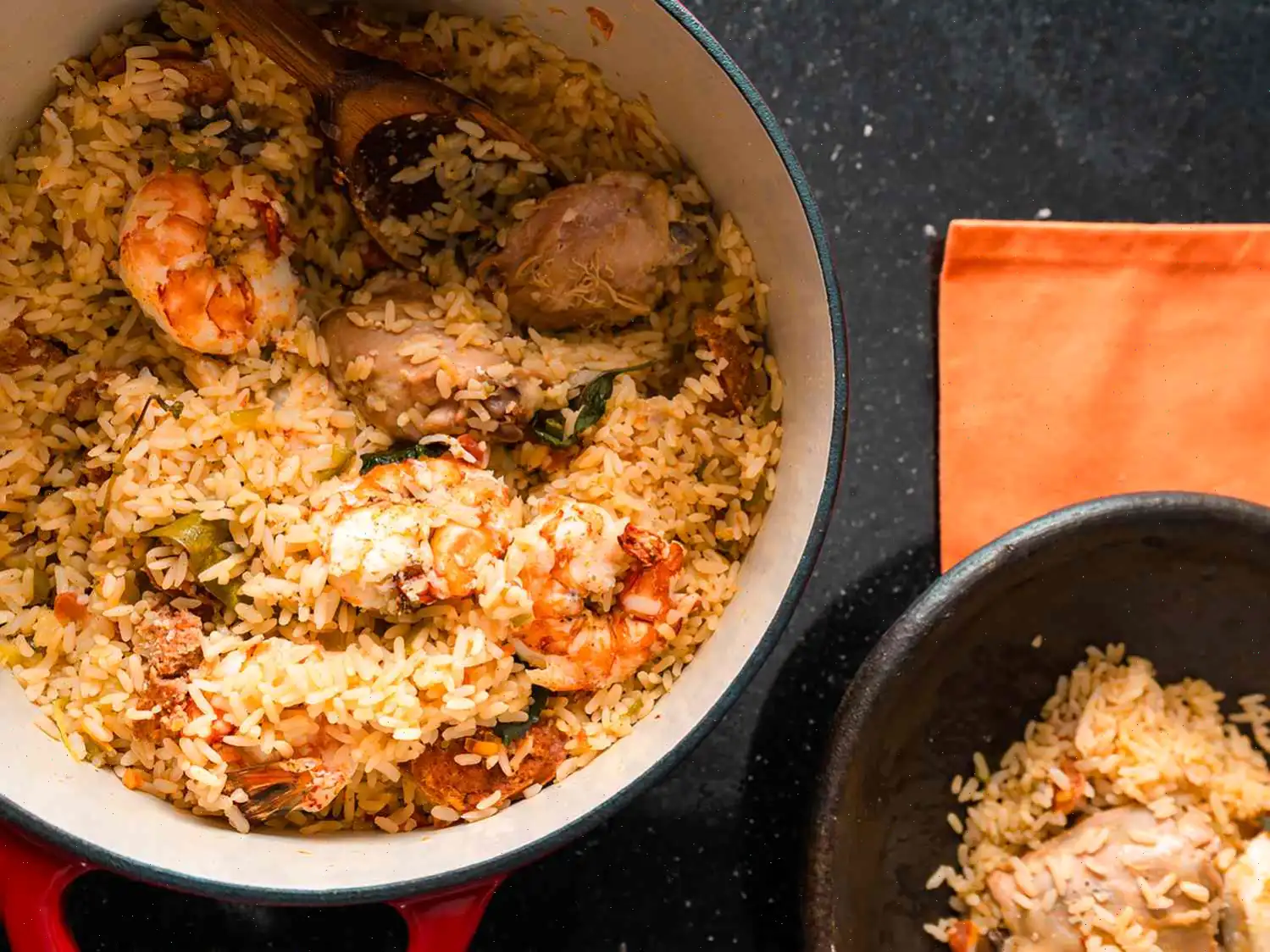
Sabzi Polo Recipe
Ingredients
- 1/2 teaspoon ground saffron
- 1/2 tablespoon plus 1/2 teaspoon kosher salt
- 2 cups basmati rice, rinsed
- 1 1/2 cups chopped fresh parsley
- 1 cup chopped fresh chives or green onion
- 1 cup chopped fresh dill
- 1 cup chopped fresh cilantro leaves
- 1 teaspoon cumin
- 1/4 cup vegetable oil
- 1 tablespoon sesame seeds
- 1/2 teaspoon turmeric
- 1 large flour tortilla
- 2 whole bulbs garlic
- 4 tablespoons ghee or butter, melted
- Lemon wedges for serving
Directions
- To bloom the saffron, sprinkle it over a few ice cubes in a small bowl. Let it sit at room temperature until the ice completely melts, about 45 minutes.
- In the meantime, bring a large pot of water to a rolling boil over high heat. Add 1 tablespoon salt and bring it back to a boil. Add the rice and cook for about 4 minutes until al dente. Drain the rice and transfer it to a large bowl. Dry the pot.
- Stir the chopped parsley, chives, dill, cilantro, cumin, and the remaining 1/2 teaspoon of salt into the rice.
- Heat the oil in the dry pot over medium heat. Once heated, sprinkle the sesame seeds and turmeric over the oil. Place the tortilla on top of the oil, followed by the rice mixture. Remove the papery outer layers of the garlic bulbs and nestle them into the rice mixture. Using the handle of a wooden spoon, poke five holes in the rice to allow steam to escape.
- Cover the pot with a clean kitchen towel and place the lid on top. Cook the rice over medium heat until you start to hear steam escaping, about 10 minutes.
- Mix the melted ghee into the saffron liquid. Pour the saffron-ghee mixture over the rice. Reduce the heat to low, cover the pot, and cook for an additional 30 to 40 minutes until the rice is tender and the garlic has softened.
- Remove the garlic bulbs from the pot. Let them cool until they're easy to handle, then peel each clove.
- Carefully place an upside-down serving platter over the pot and invert the rice onto the platter. The tortilla tahdig will be on top, forming a golden, crispy layer.
- Serve the rice with lemon wedges on the side for extra flavor.
Nutrition Facts
- Calories: 575 per serving
- Total Fat: 24g (31% DV)
- Saturated Fat: 8g (41% DV)
- Cholesterol: 22mg (7% DV)
- Sodium: 1107mg (48% DV)
- Total Carbohydrate: 83g (30% DV)
- Dietary Fiber: 8g (29% DV)
- Total Sugars: 6g
- Protein: 12g (25% DV)
- Vitamin C: 105mg (117% DV)
- Calcium: 174mg (13% DV)
- Iron: 6mg (34% DV)
- Potassium: 617mg (13% DV)

Sabzi Polo is a fragrant Iranian rice dish typically served with fried fish, especially during festive occasions such as Nowruz, the Persian New Year. The dish combines basmati rice with an aromatic blend of fresh herbs like parsley, dill, cilantro, and chives, making it a vibrant and flavorful accompaniment to various main dishes.
History and Origin
Sabzi Polo is a traditional dish with deep roots in Persian cuisine. Its origins are tied to the agricultural traditions of Iran, where rice and fresh herbs are staples. The dish is especially popular during the Persian New Year, Nowruz, which celebrates the arrival of spring. The herbs in Sabzi Polo symbolize the new growth and renewal associated with the season. Traditionally, its paired with fish, symbolizing abundance and prosperity for the coming year. The method of cooking rice in layers and creating a crispy "tahdig" at the bottom of the pot is a hallmark of Persian rice dishes.
Regional Variations
While Sabzi Polo is a beloved dish across Iran, different regions may prepare it with slight variations. In northern Iran, for example, the rice is often cooked with a larger quantity of herbs, reflecting the regions rich agricultural heritage. Some variations include the addition of dried fruits like raisins or barberries for a sweet and tangy twist. The herbs used can also vary slightly depending on what is locally available, though the core flavors of parsley, cilantro, dill, and chives are almost always present.
How It Differs from Similar Dishes
Sabzi Polo stands out from other rice dishes in Persian cuisine, such as Chelo, due to its herbaceous profile. While Chelo is a simple, steamed white rice dish often served with kebabs, Sabzi Polo includes a medley of fresh herbs that infuse the rice with bold flavors. Additionally, the crispy "tahdig" crust is a signature of many Persian rice dishes, but in Sabzi Polo, it is often made with a tortilla, giving it a unique texture and flavor that distinguishes it from other tahdig variations.
Where It Is Typically Served
Sabzi Polo is commonly served in Iranian homes during significant celebrations, especially during Nowruz. It is also a favorite at weddings, family gatherings, and other cultural events. The dish pairs beautifully with fried fish, particularly mahi, a white fish like trout or perch. The combination of the herbed rice and crispy fish is not only delicious but also culturally significant, as it embodies the spirit of renewal and prosperity.
Interesting Facts
- In Iran, rice is considered a staple food, and a meal without rice is rare. Sabzi Polo, with its fresh herbs, is a perfect representation of the Iranian love for rice.
- The "tahdig," the crispy layer of rice at the bottom of the pot, is a prized part of Persian rice dishes. Its often fought over by family members due to its unique flavor and texture.
- Persians believe that cooking rice properly is an art. The process of washing, soaking, and steaming the rice to perfection is a skill passed down through generations.
- While Sabzi Polo is often associated with fish, it can also be served with lamb, chicken, or vegetarian dishes, depending on the occasion.
FAQ about Sabzi Polo Recipe
Comments
Amy Harris
12/21/2022 03:45:28 PM
Super simple to prepare and bursting with amazing flavor! My whole family absolutely adored this dish! I will definitely be whipping this up again in the future. Paired perfectly with some crispy fried fish.








